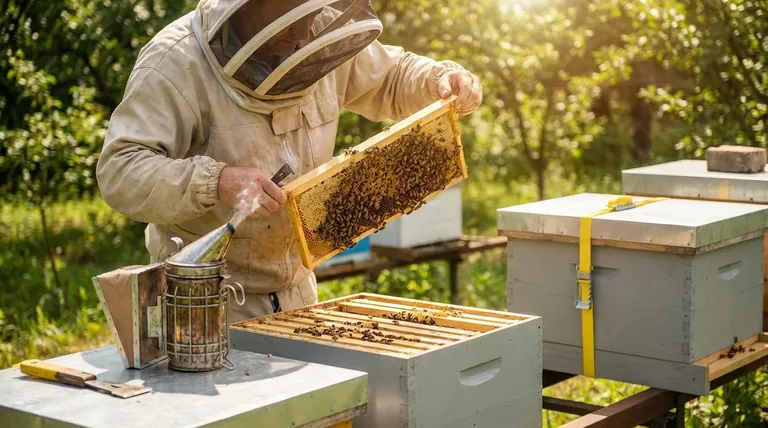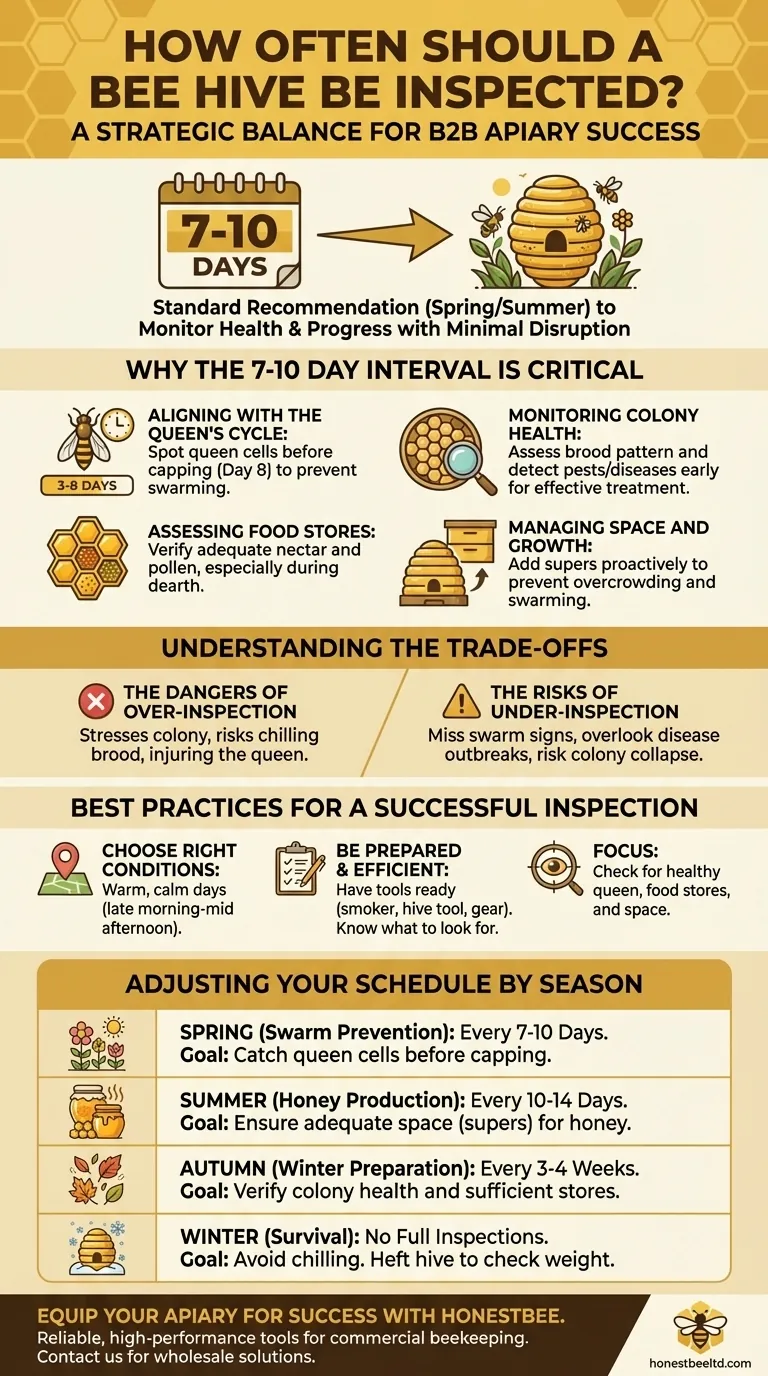The standard recommendation for hive inspections is every 7 to 10 days, particularly during the spring and summer months. This interval is a strategic balance, allowing you to monitor the colony's health and progress without causing excessive stress or disruption to the bees' vital work. The frequency, however, should adapt to the season and your specific goals.
The 7-10 day inspection cycle is not arbitrary; it's timed to the queen bee's reproductive cycle. This schedule allows you to identify and address critical issues, such as swarm preparations or a failing queen, before they escalate into unmanageable problems.

Why the 7-10 Day Interval is Critical
The primary purpose of an inspection is to gather information with minimal disruption. Each time you open the hive, you break the propolis seals the bees have made and temporarily disrupt the colony's temperature and humidity control. Therefore, your inspections must be efficient and purposeful.
Aligning with the Queen's Cycle
A worker bee egg hatches into a larva in about 3 days. If the colony decides to raise a new queen (often in preparation to swarm), they will build a special queen cell around a young larva. This cell is capped around day 8.
Inspecting every 7-10 days ensures you can spot these queen cells before they are capped, giving you time to intervene and prevent the colony from swarming and losing half its population.
Monitoring Colony Health
Regular checks allow you to assess the brood pattern. A healthy queen lays eggs in a dense, contiguous pattern. A spotty or inconsistent pattern can be an early warning sign that the queen is failing or the hive is dealing with disease.
You are also looking for signs of pests like varroa mites or diseases. Early detection is crucial for effective treatment.
Assessing Food Stores
Bees require a constant supply of nectar (honey) and pollen to feed themselves and raise new brood. During an inspection, you must verify that they have adequate stores, especially if there is a "nectar dearth" or a period of poor weather.
Managing Space and Growth
A rapidly growing colony can quickly run out of space, which is a primary trigger for swarming. Regular inspections let you see when the bees are beginning to draw out comb on the final frames in a box.
This is your cue to add another super (hive box), providing them with the necessary room to expand the brood nest and store more honey.
Understanding the Trade-offs
Adhering to a rigid schedule without considering the context can be counterproductive. The key is to understand the risks of both over- and under-inspection.
The Dangers of Over-Inspection
Inspecting too frequently (e.g., every few days) can be highly detrimental. It stresses the colony, which can lead to more defensive behavior.
Each time the hive is opened, you risk chilling the brood and killing larvae. You also increase the chances of accidentally "rolling" and killing bees, or worse, injuring the queen.
The Risks of Under-Inspection
Waiting too long between inspections (e.g., a month during peak season) is equally dangerous. You can easily miss the signs of swarm preparation, and by the time you check, half your bees may already be gone.
Furthermore, a disease outbreak, a pest infestation, or a failed queen can go unnoticed, leading to the rapid decline and potential collapse of the entire colony.
Best Practices for a Successful Inspection
How you inspect is as important as how often. A calm, efficient inspection minimizes stress on both you and the bees.
Choose the Right Conditions
The best time to open a hive is on a warm, clear, and calm day, ideally between late morning and mid-afternoon. During this time, a large portion of the foragers will be out of the hive, reducing traffic and defensive behavior inside.
Be Prepared and Efficient
Have your tools—a smoker, a hive tool, and your protective gear—ready before you approach the hive. Know what you are looking for before you open it up. A typical inspection should focus on finding evidence of a healthy queen (eggs and larvae), checking food stores, and assessing space.
Adjusting Your Schedule by Season
A skilled beekeeper is responsive, not rigid. Your inspection frequency must adapt to the colony's annual lifecycle.
- If your primary focus is swarm prevention (Spring): Adhere strictly to the 7-10 day schedule to catch queen cells before they are capped.
- If your primary focus is honey production (Summer): Maintain a 10-14 day schedule, ensuring bees have enough space (supers) to store incoming nectar.
- If your primary focus is winter preparation (Autumn): Reduce inspections to once every 3-4 weeks, focusing on colony health and ensuring they have sufficient honey stores to survive winter.
- If your primary focus is survival (Winter): Do not open the hive unless an emergency is suspected. A quick lift or "heft" of the hive from the back can tell you if it feels heavy enough with honey.
Ultimately, observation is your most powerful tool; let the needs of the colony, not the calendar, dictate your actions.
Summary Table:
| Season | Primary Focus | Inspection Frequency | Key Goal |
|---|---|---|---|
| Spring | Swarm Prevention | Every 7-10 Days | Catch queen cells before they are capped. |
| Summer | Honey Production | Every 10-14 Days | Ensure adequate space for honey storage. |
| Autumn | Winter Preparation | Every 3-4 Weeks | Verify colony health and sufficient honey stores. |
| Winter | Survival | No Full Inspections | Avoid chilling the cluster; heft the hive to check weight. |
Ready to Equip Your Apiary for Success?
Consistent, effective hive inspections are the foundation of a thriving apiary. HONESTBEE is your trusted partner, supplying commercial apiaries and beekeeping equipment distributors with the durable, high-performance tools needed for efficient hive management. From reliable smokers and hive tools to protective gear and full hive systems, we support your operations with wholesale-focused solutions.
Let's build a more productive and resilient beekeeping operation together. Contact our team today to discuss your equipment needs and wholesale pricing.
Visual Guide

Related Products
- Professional Galvanized Hive Strap with Secure Locking Buckle for Beekeeping
- Versatile Ratchet Hive Strap with S-Hooks for Secure Fastening
- HONESTBEE Professional Frame Wiring Board and Jig
- Professional Replacement Bee Smoker Bellows for Beekeeping Equipment
- Mesh Ventilated 3 Layer Goatskin Beekeepers Gloves for Beekeeping
People Also Ask
- Can straps with hook ends be used for beehives? A Guide to Secure Hive Management
- What are the types of Emlocks available? Choose the Right Strap for Hive Security
- What is the best length for straps used around beehives? Why 12 Feet is the Industry Standard
- How can beekeepers secure the top cover of a hive? Protect Your Colony from Wind and Weather
- What are hive straps and why are they used? Secure Your Hives Against Wind, Predators, and Transport



















